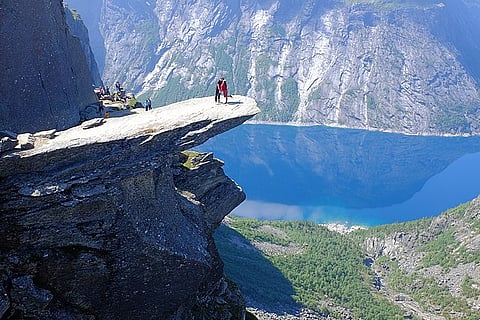
- Destinations
- Experiences
- Stay
- What's new
- Celebrating People
- Responsible Tourism
- CampaignsCampaigns
- Subscribe
- Buy Now

Caminito Del Rey, Spain
Caminito Del Rey is a dangerous walking trail that skirts the Guadalhorce River gorge near El Chorro in southern Spain. Dubbed the "scariest walking trail in the world," it was built 109 years ago to link the hydroelectric plants along the river. The four-kilometre-long stretch includes the infamous cliffside section of Desfiladero de los Gaitanes, which has enormous drops down to the river, and several other equally dangerous but breathtaking sections. This walk, which translates to 'The King's Path,' is one of the most difficult in the world. Hikers traverse limestone cliffs on narrow wooden walkways. The trail was blocked to hikers in 2001 after five individuals died after falling into the river below. El Caminito Del Rey reopened in 2015 after a refurbishment in which fences were installed to the walkway, and it is now much safer than previously, affording vistas of turquoise rivers and lovely valleys.
Trolltunga, Norway
Trolltunga (the troll's tongue) and the valley below were cut out by an icecap that blanketed most of Scandinavia during a series of ice ages near the town of Odda on the western side of the Hardangervidda mountain plateau. Every year, visitors from all over the world come to undertake the walk and take photos on or in front of the world-famous cliff. The Trolltunga Trail is a challenging trek for advanced trekkers. Trekking through alpine vegetation and Arctic tundra, you'll encounter various landscapes, from beautiful valleys to majestic mountain peaks. The highlight of this trail is the legendary Trolltunga, a massive rock formation jutting out horizontally above Lake Ringedalsvatnet. From this point, you can also check out the surreal views of glacial valleys and distant snow-capped mountains.
Fagradalsfjall, Iceland
Fagradalsfjall is an Icelandic volcanic peak that has recently attracted attention due to its ongoing eruption. On the evening of March 19, 2021, an eruptive fissure emerged in the Geldingadalir valleys, bringing the Icelandic volcano Fagradalsfjall on the Reykjanes peninsula into the spotlight. It had been dormant for nearly 6,000 years before becoming the first active volcano in the Reykjanes UNESCO Global Geopark area in 800 years. Getting to this place necessitates a long journey via rocky terrain and navigating the constantly changing volcanic activity.
Danakali Depression, Ethiopia
This location in northern Ethiopia is difficult to reach for a variety of reasons. The desert plain is approximately 410 feet (125 metres) below sea level and is one of the hottest and most hostile regions on Earth, with temperatures averaging 94 degrees Fahrenheit (34.5 Celsius) but exceeding 122 degrees Fahrenheit (50 Celsius). The area has sulphur springs, volcanoes, geysers, enormous salt pans, and mineral-laden lakes. Volcanic activity heats spring water, bringing sulphur and iron to the surface and depositing yellow, green, and orange minerals. Though local people have been travelling to the place in camel caravans for decades to mine the salt, in recent years, some have started guiding tourists to this surreal region.
Death Valley, USA
Nothing compares to witnessing the desert at its most extreme at Death Valley, Mojave Desert, California. This desert on the California-Nevada border is best approached from the west, past the gnarled Joshua trees of Panamint Springs. Then, climb to Towne Pass, where the temperature is approximately 5,000 feet and 200 degrees Celsius. Then, for the next 20 kilometres, roll down your windows and hold out a hand as you descend to Stovepipe Wells, which is 100 feet below sea level and 550 degrees Celsius. Glistening salt flats, windswept sand dunes, and a riot of colour on the cliffs at Zabriskie Point will entice you.
